You will find articles organized by categories, along with recent comments, along the right hand column of the website. If you are just getting started with the idea of converting a gas car to electric be sure to check out Your First Electric Car
Welcome and enjoy!
-Jerry
Stuck at B · 8 May 06
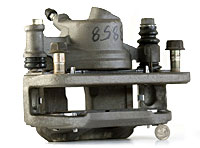
I’ve been supporting the local economy lately: buying up lots of their old car parts and then paying a local shop to press them into place.
Last week marked the end (well, almost) of the brake and bearing work. As for the rest of the items in the “B” alphabet we are still stuck on the Battery part, but making some progress.
On the front end I replaced both calipers and the brake pads as well as the front left bearing. Checked out the struts and they seem to be in fine shape. So I put the half-shafts back in place (really more like 1/3 and 2/3rds shafts), tightened everything down and put the wheels back on.
The back end got a similar treatment. Since I didn’t have much success finding rear disc assemblies I finished replacing the old drum hardware, including the rear bearings.
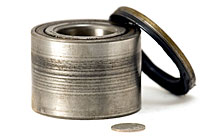
The bearings aren’t at all what I was expecting. All of the cars I’ve worked on in the past have had tapered bearings: pretty easy to pop out, inspect/replace, and grease up. I use the old style technique of spreading grease on my palm and then squooshing it through the bearings…even showed my wife how to do it with the last set we worked on. They make devices for doing this, but what’s the fun in that?
None of that with the Ford Probe bearings. As you can see they use huge sealed bearings that cost about $50 each and require a hefty press or special equipment to pop out and replace. But I figured since I had everything taken apart I might as well ensure the car has as little rolling resistance as possible.
The struts on the back are less firm than the front, most likely because they aren’t supporting as much weight. I’ll probably need to replace them at some point, but I decided to wait until the battery issue is resolved and I know exactly how much weight they’ll need to handle. In the meantime I put everything back together and bolted the wheels back on.
With all of this put back together and the wheels back on there was only one thing to do: roll Eve out into the driveway and clean the garage!
Seriously, a winter’s worth of working on Eve in the corner of an already messy garage had turned it into an unmanageable mess. My Sunday was spent cleaning things up and organizing all of Eve’s old and new parts.

The next item on Eve’s agenda is nailing down the batteries.
This photo shows the two front battery boxes used for the last EV. They worked well: insulated, leak-proof, and cheap to build. Not all that stylish (unless you like baby-blue) they were built large enough to handle the 12volt SCS225 batteries with enough room for possibly upgrading to slightly larger deep cycles down the road.
My hope for Eve is to NOT use flooded lead-acid batteries this time, maybe get a battery that offers more options for a clean layout.
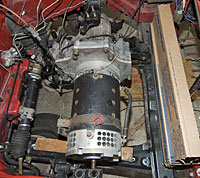
If you read through the my last battery dilemma post you might remember the Eagle/Picher Horizon battery. It is a sealed AGM lead-acid that is uniquely shaped: 30” x 5” x 4”.
To do a little what-if layout I cut up a fluorescent light fixture box into approximately 30” x 4” x 2.5” sections. Two sections stacked on top of each other is roughly the same size as one of the batteries.

Thirty inches seems to be a pretty good size, fitting lengthwise across the engine compartment, either in the space where the radiator used to be or in a flat pack above the motor. Not needing to water the batteries means they can be put in place and, hopefully, left alone for their lifetime.
A few things make laying the batteries out difficult. The brake booster and cylinder jut out and monopolize a whole corner. And then there are three big engine mounts to work around. The old radiator opening is usually on the small side, no matter what battery you use. I’m not sure how integral it is to the front end’s support, but it may be possible to cut it open a bit more and then shore up with a rigid steel frame around the batteries.
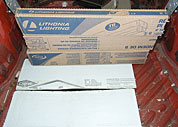
Lots of room in the back. With this particular battery I can even squeeze one in the center hump where the muffler used to run. One or two could go into the space for the gas tank, maybe more if I modified the shape a bit. There’s a couple butt-shaped depressions for the back seats that keep it from being a perfect battery mounting spot.
Of course the trunk is a fine place too, as you can see. I could do something like Peter did with his lithium batteries, mounting them horizontally in a “sandwich” configuration with insulation below and above. The really big win with this approach is not having to cut a hole in the trunk and/or welding in a battery box.
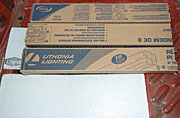
The other thing I’m considering is dropping down to a 120vdc pack. That’s ten batteries instead of twelve, and if I use the Horizons it means only 550lbs of battery weight. Five batteries in the back (275lbs), maybe one battery down the center, and four batteries up front would provide nice weight distribution.
I ran the numbers through the EV calculator and range wise I’d be losing about six miles or so. Acceleration wouldn’t be as good, but probably more than sufficient. It would also be cheaper…money that can go towards making a BMS.
No, the big problem with these batteries is getting the company to SELL them. I’ve gotten a price for a single battery, but have yet been able to get a quote for the ten or twelve that I’ll be buying along with the freight to ship them.
If there’s anyone else in the New England area that is interested in buying these batteries drop me an email. We can get a better price per battery and probably for shipping if we buy a pallet of 30.
p.s. the only thing left to do with the brakes is get a new booster. After all of that work cleaning it up it still doesn’t keep a vacuum very well. A rebuild kit would work too, if they sell them.
UPDATE: No go on the batteries, the price stays the same even if I buy a dozen. To add insult to injury they don’t provide any warranty if the batteries are used on an EV. Time for plan B…



Jerry,
Out of curiousity how much did they quote per battery?Hi Jerry, Have you looked into the Lifeline AGM batteries? They have an 80ah or so battery with a built in handle, same weight as the horizon but with a network of local distributors….I don’t know the prices but perhaps they will be more reasonable. Their life cycle charts are pretty impressive, too, with a reputed 1000cycles at 50% dod.
Hi Lee,
I don’t recall if they are on my list or not. Do you have any first hand experience with them?
I checked the EVAlbum and didn’t find any EVs using them (perhaps they have a different name?).
BTW folks, even though I wrote the code, I only just now remembered that you can summarize the EVs in the album by battery brand. This way you can see who else is using the battery you are considering and even drop them an email for feedback. That’s what I’m doing for Plan B.
Hey Peter, just realized that the response I thought I posted yesterday didn’t actually make it.
The quoted price was $275, buying one or buying a dozen. Add to that another $200 for shipping and it would have been over three grand. No local or regional dealer, so the purchase would have been through their Oklahoma office.
I’ve heard of other batteries having reduced warranties when used in an EV. Be sure to check before you buy.
Hi Jerry,
Don’t have experience, my ev is still in the planning stages (though I do own the future donor vehicle). It seems Lifeline and Concorde are the same or similar…..does that help?
Jer, Jer, Jer… If you only had gone to MIT and joined the right frat, then it would be as simple as A123 All you would have to do is give Brother Dave a call, eh?
Dave? Hi, this is Jerry Halstead.
Jerry? You old dog, how’s it hanging?
Hey, Dave, I saw where you gave those Killacylers a battery pack to test.
Yeah! Mister Cool Dube has got it. 800 A123 Systems Li-Ion cells configured to deliver 340 volts at up to 1300 amps.
Weight just under 150 pounds. The story said that this pack holds about “9 kW-hrs of energy!”Is that true?
Yep.
Dave… I’ve got this girl I want you to meet.
Jer, you old dog, you.
...ah yes. The elite club of the “brass rat.” Membership has its privileges.
Thanks Lee, that helps.
JC, I’ll get right on that. Uh, how do you spell MIT?
I know these are lead acid batteries, but Trojan has their new T1275 batteries that are not in your spreadsheet. Has anyone recieved a quote on these or looked into them yet? I’m also just at the stage of needing to decide on batteries to start making boxes.
next time you need to grease bearings and don’t want to get to messy. try using a zip lock bag. fill it full of grease, drop in the bearing, and mush or squeeze or fondle. just an old maintenance trick i picked up.
Good idea, thanks Joe!
HI HAS ANY ONE USED THAT HORIZON BATT IS IT ANY GOOD WHAT DO YOU THINK